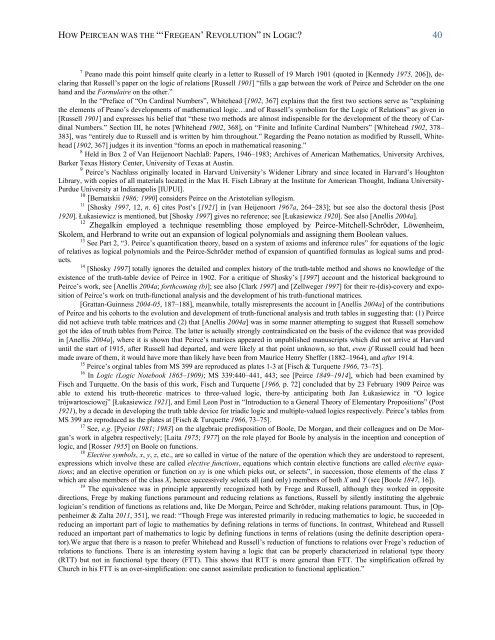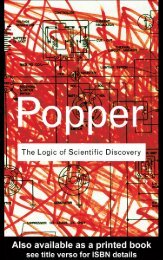Create successful ePaper yourself
Turn your PDF publications into a flip-book with our unique Google optimized e-Paper software.
HOW PEIRCEAN WAS THE “‘FREGEAN’ REVOLUTION” IN LOGIC? 40<br />
7<br />
Peano made this point himself quite clearly in a letter to Russell of 19 March 1901 (quoted in [Kennedy 1975, 206]), declaring<br />
that Russell’s paper on the logic of relations [Russell 1901] “fills a gap between the work of Peirce and Schröder on the one<br />
hand and the Formulaire on the other.”<br />
In the “Preface of “On Cardinal Numbers”, Whitehead [1902, 367] explains that the first two sections serve as “explaining<br />
the elements of Peano’s developments of mathematical logic…and of Russell’s symbolism for the Logic of Relations” as given in<br />
[Russell 1901] and expresses his belief that “these two methods are almost indispensible for the development of the theory of Cardinal<br />
Numbers.” Section III, he notes [Whitehead 1902, 368], on “Finite and Infinite Cardinal Numbers” [Whitehead 1902, 378–<br />
383], was “entirely due to Russell and is written by him throughout.” Regarding the Peano notation as modified by Russell, Whitehead<br />
[1902, 367] judges it its invention “forms an epoch in mathematical reasoning.”<br />
8<br />
Held in Box 2 of Van Heijenoort Nachlaß: Papers, 1946–1983; Archives of American Mathematics, University Archives,<br />
Barker Texas History Center, University of Texas at Austin.<br />
9<br />
Peirce’s Nachlass originally located in Harvard University’s Widener Library and since located in Harvard’s Houghton<br />
Library, with copies of all materials located in the Max H. Fisch Library at the Institute for American Thought, Indiana University-<br />
Purdue University at Indianapolis [IUPUI].<br />
10<br />
[Bernatskii 1986; 1990] considers Peirce on the Aristotelian syllogism.<br />
11<br />
[Shosky 1997, 12, n. 6] cites Post’s [1921] in [van Heijenoort 1967a, 264–283]; but see also the doctoral thesis [Post<br />
1920]. Łukasiewicz is mentioned, but [Shosky 1997] gives no reference; see [Łukasiewicz 1920]. See also [Anellis 2004a].<br />
12<br />
Zhegalkin employed a technique resembling those employed by Peirce-Mitchell-Schröder, Löwenheim,<br />
Skolem, and Herbrand to write out an expansion of logical polynomials and assigning them Boolean values.<br />
13<br />
See Part 2, “3. Peirce’s quantification theory, based on a system of axioms and inference rules” for equations of the logic<br />
of relatives as logical polynomials and the Peirce-Schröder method of expansion of quantified formulas as logical sums and products.<br />
14<br />
[Shosky 1997] totally ignores the detailed and complex history of the truth-table method and shows no knowledge of the<br />
existence of the truth-table device of Peirce in 1902. For a critique of Shosky’s [1997] account and the historical background to<br />
Peirce’s work, see [Anellis 2004a; forthcoming (b)]; see also [Clark 1997] and [Zellweger 1997] for their re-(dis)-covery and exposition<br />
of Peirce’s work on truth-functional analysis and the development of his truth-functional matrices.<br />
[Grattan-Guinness 2004-05, 187–188], meanwhile, totally misrepresents the account in [Anellis 2004a] of the contributions<br />
of Peirce and his cohorts to the evolution and development of truth-functional analysis and truth tables in suggesting that: (1) Peirce<br />
did not achieve truth table matrices and (2) that [Anellis 2004a] was in some manner attempting to suggest that Russell somehow<br />
got the idea of truth tables from Peirce. The latter is actually strongly contraindicated on the basis of the evidence that was provided<br />
in [Anellis 2004a], where it is shown that Peirce’s matrices appeared in unpublished manuscripts which did not arrive at Harvard<br />
until the start of 1915, after Russell had departed, and were likely at that point unknown, so that, even if Russell could had been<br />
made aware of them, it would have more than likely have been from Maurice Henry Sheffer (1882–1964), and after 1914.<br />
15<br />
Peirce’s orginal tables from MS 399 are reproduced as plates 1-3 at [Fisch & Turquette 1966, 73–75].<br />
16<br />
In Logic (Logic Notebook 1865–1909); MS 339:440–441, 443; see [Peirce 1849–1914], which had been examined by<br />
Fisch and Turquette. On the basis of this work, Fisch and Turquette [1966, p. 72] concluded that by 23 February 1909 Peirce was<br />
able to extend his truth-theoretic matrices to three-valued logic, there-by anticipating both Jan Łukasiewicz in “O logice<br />
trójwartosciowej” [Łukasiewicz 1921], and Emil Leon Post in “Introduction to a General Theory of Elementary Propositions” (Post<br />
1921), by a decade in developing the truth table device for triadic logic and multiple-valued logics respectively. Peirce’s tables from<br />
MS 399 are reproduced as the plates at [Fisch & Turquette 1966, 73–75].<br />
17<br />
See, e.g. [Pycior 1981; 1983] on the algebraic predisposition of Boole, De Morgan, and their colleagues and on De Morgan’s<br />
work in algebra respectively; [Laita 1975; 1977] on the role played for Boole by analysis in the inception and conception of<br />
logic, and [Rosser 1955] on Boole on functions.<br />
18<br />
Elective symbols, x, y, z, etc., are so called in virtue of the nature of the operation which they are understood to represent,<br />
expressions which involve these are called elective functions, equations which contain elective functions are called elective equations;<br />
and an elective operation or function on xy is one which picks out, or selects”, in succession, those elements of the class Y<br />
which are also members of the class X, hence successively selects all (and only) members of both X and Y (see [Boole 1847, 16]).<br />
19<br />
The equivalence was in principle apparently recognized both by Frege and Russell, although they worked in opposite<br />
directions, Frege by making functions paramount and reducing relations as functions, Russell by silently instituting the algebraic<br />
logician’s rendition of functions as relations and, like De Morgan, Peirce and Schröder, making relations paramount. Thus, in [Oppenheimer<br />
& Zalta 2011, 351], we read: “Though Frege was interested primarily in reducing mathematics to logic, he succeeded in<br />
reducing an important part of logic to mathematics by defining relations in terms of functions. In contrast, Whitehead and Russell<br />
reduced an important part of mathematics to logic by defining functions in terms of relations (using the definite description operator).We<br />
argue that there is a reason to prefer Whitehead and Russell’s reduction of functions to relations over Frege’s reduction of<br />
relations to functions. There is an interesting system having a logic that can be properly characterized in relational type theory<br />
(RTT) but not in functional type theory (FTT). This shows that RTT is more general than FTT. The simplification offered by<br />
Church in his FTT is an over-simplification: one cannot assimilate predication to functional application.”





